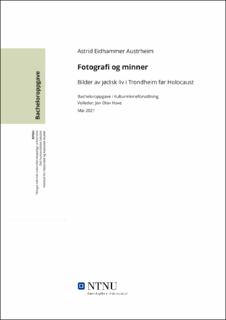| dc.contributor.advisor | Hove, Jon Olav | |
| dc.contributor.author | Austrheim, Astrid Eidhammer | |
| dc.date.accessioned | 2021-09-13T16:11:26Z | |
| dc.date.available | 2021-09-13T16:11:26Z | |
| dc.date.issued | 2021 | |
| dc.identifier | no.ntnu:inspera:80492741:37063954 | |
| dc.identifier.uri | https://hdl.handle.net/11250/2775817 | |
| dc.description.abstract | Denne oppgaven har tre problemstillinger; Hvordan kan fotografiet påvirke hva vi husker eller glemmer om fortida? Hva skjer med en bildesamling når den er digital? Hva kan en digital bildesamling fortelle oss om jødisk minne i Trondheim? Fotografi har den spesielle egenskapet at det kan være med på å styrke minnet. Med andre ord kan fotografier få oss til å minnes fortida bedre. Videre hevdes det i noen tilfeller at digitalisering blir et ledd i å forevige det utslitte fotografiske materialet som ligger oppbevart i arkivet. Digitalisering endrer forholdet mellom minnet og fotografi. Fra å være passivt arkivert i magasinet får fotografier nytt liv på nett. Gjennom en kvalitativ undersøkelse vil denne oppgaven se nærmere på hvilken påvirkning en digital fotosamling har på minnet om jødisk historie i Trondheim før Holocaust. Hovedkonklusjonen i oppgaven er at det er et ubrukt potensiale for bildene i arkivet. Hvis de blir tatt i bruk åpnes det for at de går fra å være passive til aktive minner. Det nesten hverdagslige bildet med sin undertekst kan gjøre stort inntrykk. Vi trenger ikke bare billedlig grusomhet for å huske Holocaust. | |
| dc.description.abstract | This thesis has three issues; How can photography affect what we remember or forget about the past? What happens to an image collection when it is digital? What can a digital photo collection tell us about Jewish memory in Trondheim? Photography has the special property that it can help strengthen memory. In other words, photographs can make us remember the past better. Furthermore, it is claimed in some cases that digitization becomes a part of immortalizing the worn-out photographic material stored in the archive. Digitization changes the relationship between memory and photography. From being passively archived in the magazine, photographs get a new life online. Through a qualitative study, this thesis will take a closer look at the impact a digital photo collection has on the memory of Jewish history in Trondheim before the Holocaust. The main conclusion of the thesis is that there is an unused potential for the images in the archive. If they are used, it opens up for them to go from being passive to active memories. The ordinary image with its subtext can make a big impression. We do not just need pictorial cruelty to remember the Holocaust. | |
| dc.language | nob | |
| dc.publisher | NTNU | |
| dc.title | Fotografi og minner. Bilder av jødisk liv i Trondheim før Holocaust | |
| dc.type | Bachelor thesis | |
